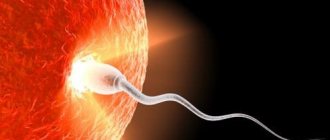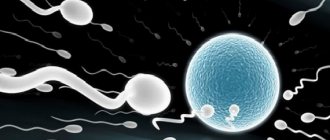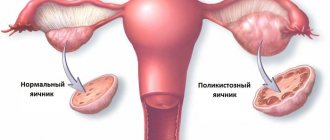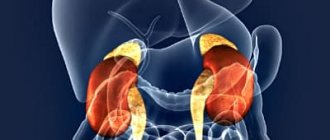Why do I have irregular periods?
For men, this is the only hormonal regime necessary to maintain the desired level of androgens. But for girls, changes at the hormonal level occur constantly: changes happen several times a month. That is why the duration or frequency of the cycle can change and even completely healthy girls face this.
External reasons
These include neuroses, severe stress, climate change when moving or on vacation, intellectual, psychological or physical overstrain, diets and fasting, stabilization of sex life or abrupt cessation, chronic fatigue, addiction to alcohol, drugs and nicotine, as well as coffee.
The violations can be explained by the fact that before ovulation the hormone estrogen is responsible for everything, and after that it is progesterone. The second phase, the time of progesterone, is constant and lasts from 11 to 16 days. The first, controlled by estrogen, can last as long as desired and is generally individual. It is during this period that all conditions for conception are created.
But if there is constant stress in your life, alcohol abuse, hunger strikes, or your health leaves much to be desired, the body needs much more time to create the conditions for conception. And if the unfavorable period drags on, ovulation may stop coming altogether. But let's get back to the reasons.
Another external reason can be called...a vacation overseas. No matter how strange it may sound. Firstly, even positive emotions are perceived by a woman’s body as stress. Secondly, this is a change in climate, to which the hormonal system can also react violently. If you like active recreation, with hikes and excursions, then this may also be one of the reasons why the cycle has gone astray, especially if in ordinary life you prefer to relax in front of the TV and work at the computer.
Internal problems
They are more difficult to deal with. First of all, these are diseases. For example, ailments of the genitourinary system itself. This includes endometriosis, inflammatory processes in the appendages, cysts, and tumors. Problems with the pituitary gland may also be to blame. Sometimes cycle disorders are provoked by inflammatory, somatic or infectious diseases that have nothing to do with the sexual sphere. The body is still weakened, which means it cannot properly prepare for pregnancy.
First of all, hormonal, and we are talking not only about contraceptives, but also about other means. All of them can make menstruation scanty and short-lived, and if the means are chosen incorrectly, they affect both the duration of the cycle and the characteristics of its course. It is especially famous for its ability to disrupt the postinor cycle.
Antiulcer drugs also delay the onset of menstrual periods. They may well delay your period. Another provocateur is blood-stopping drugs.
- The intrauterine device may also be to blame. Some of them release a certain amount of hormones, others cause miscarriage at the end of the cycle.
- Abortions (both spontaneous and induced) and breastfeeding can also affect the cycle.
Unfortunately, calendar methods are not helpful in finding day X if the cycle is irregular. But you still shouldn’t despair, because there are other ways to find it. True, some can be combined.
Ovulation tests
As we found out earlier, the female body obeys hormones. When the egg matures, the luteinizing hormone, also known as LH, becomes the main hormone. It is present in urine, saliva, and blood, so it can be determined using a test. Diagnosis using tests is based on determining PH. By the way, ovulation tests are different:
- Strip (strip test)
- Tablet
- Jet
- Portable reusable
- Digital (determine the release of an egg from saliva).
As with pregnancy tests, sometimes two lines are all it takes to tell the whole story. More high-tech tests work differently.
There is one more key point. The test result does not indicate the actual release of the egg, but simply records the most active surge of the ovulation hormone. The extremely high level of this hormone lasts less than 24 hours, so it is better to test twice a day. To more accurately capture the moment of X.
If you have an irregular cycle, you need to take your shortest cycle over the last seven months as the unit of measurement (keep track!). Tests should be carried out at the following time intervals:
- If the cycle is 32 days, we test 5-7 days from the 15th day after the start of the critical days;
- If the cycle is 26 days - the same five days in a row but from the seventh day after the onset of menarche;
- With a 24-day cycle - from the ninth day.
The disadvantages of the tests are their high price and imperfect accuracy: it is very difficult to determine when a cell has come out for sure. In addition, some illnesses can cause an increase in the level of luteinizing hormones. These are PCOS and many endocrine disorders. The same problems arise when conducting laboratory tests for hormones.
Temperature method
This method is sometimes called ideal. The only difficulty is that you will have to measure your basal temperature every morning for at least three months in a row. (For those who have never done it: the procedure is carried out immediately upon waking up, before getting out of bed and going to the toilet. The thermometer can be inserted into the rectal opening, or into the vagina).
- After the start of the critical days and until the release of the egg, the temperature ranges from the usual 36.6 to 36.8-9;
- A couple of days before leaving, the temperature drops by 0.2-0.3 degrees, after which it immediately jumps (37.2). This is ovulation;
- The rest of the time we live with a temperature of 37 degrees, before menstruation it drops by about a third of a degree. There may be other numbers, but ups and downs mean hormonal changes.
Examination by a gynecologist
An ideal option, because it will definitely “feel” for ovulation. Just don’t go to him every day.
It couldn't be more reliable. In addition, the method is quite harmless. The first visit to the ultrasound room should be scheduled for 7-8 days after the arrival of the critical days. The next one is the twelfth day, when healthy women begin to ovulate. The following studies are at your request and the recommendation of a gynecologist. If the follicle size is between 18 and 21 mm, ovulation is just around the corner. And if it bursts, perhaps you will become a mother soon.
Usually during the period of ovulation, events and changes occur that many girls notice very well. Firstly, pain in the abdomen (usually in the ovary or uterus) is often observed at this time. They are shooting, tingling, pulling or premenstrual-like.
The second point that cannot be ignored is the thickness of the cervical fluid. It becomes similar in consistency to egg white and there is more of it than usual. You can check it by placing your finger on the cervix. By the way, during ovulation the cervix opens wider and becomes softer. If you examine the cervix with your finger, you will notice that the temperature in the vagina is high during the period of cell release.
What else can you notice during this period? Girls who do gymnastics or dance notice that during ovulation they have more energy and their workouts are productive, and their bodies become more flexible.
At this time, productivity also increases. There is also a desire to communicate more actively with the opposite sex, go to parties or something similar. Finally, sexual arousal may increase. If all this is confirmed by BT studies, tests or a gynecologist, you can safely state ovulation.
What changes in a woman's body during ovulation?
Ovulation is the release of an egg ready for fertilization from the ovarian follicle. In an ideal 28-day menstrual cycle, this occurs approximately on days 12–14. But calculating ovulation with an irregular cycle is not so easy, since it can happen on any day.
All processes in a woman’s body depend on her hormonal levels, especially the maturation of the follicle and egg. In order for ovulation to occur correctly, there must be a sharp rise in the luteinizing hormone of the pituitary gland, as a result of which a microtear is formed on the ovary, from where a mature egg appears. Next, progesterone promotes the growth of the endometrium in the uterine cavity in order to prepare a “bed” for the woman’s fertilized reproductive cell. If conception does not occur, the inner layer of the uterus is shed and menstruation occurs. If you carefully monitor your body, all these hormonal ups and downs can be easily tracked.
You should also know that the release of an egg for a woman is an irregular process. There is an assumption that ovulation occurs only once every two to three months. This is how the body protects the cells that are “important” for it, without simply wasting them. Therefore, if you do not reveal a single symptom in a certain month, or notice that all the signs are blurred, you should not be upset: most likely, everything was done correctly, it’s just that this month is “empty”.
Changes in behavior at the time of ovulation
An increase in a woman's sexual desire is genetically programmed on the eve of the release of an egg from the ovary and a day or two after. The body of the fair sex begins to produce special ferromones - chemical compounds secreted along with other biological fluids (sweat, urine, vaginal secretions, etc.) and help increase libido on the part of the opposite sex.
That is why these days a woman is especially attractive and sexy for her man and is easily excitable. And, conversely, those who have problems with the ovaries and female sex hormones have a constantly reduced sex drive, it is more difficult for them to achieve orgasm, and they are often frigid. Therefore, you can judge whether there is ovulation during an irregular cycle using observations of your own libido.
The nature of vaginal discharge on favorable days
Leucorrhoea is also subject to cyclical changes. Immediately after menstruation, there may be virtually no discharge. But approaching ovulation with an irregular cycle, the girl notes that mucus periodically appears from the vagina, and its viscousness increases the closer to the day the egg is released. Sometimes such discharge is compared to egg white, but it may have a slightly whitish tint. A large amount of discharge should not be alarming; sometimes it even becomes necessary to use panty liners.
This nature of leucorrhoea ensures the unhindered flow of sperm into the cervical canal, into the uterine cavity and further to the egg. This is the basis of one of the effects of contraceptives - an increase in the viscosity of mucus, which is a kind of barrier to fertilization.
During ovulation, as a rule, there is no feeling of dryness and discomfort in the vagina, including during sexual intercourse.
We recommend reading the article about spotting during ovulation. From it you will learn about the causes of gynecological bleeding in the middle of the menstrual cycle, the opinion of specialists about spotting before and after ovulation, and the provision of medical care.
Changes in the properties of saliva
You can catch ovulation not only by studying the nature of discharge from the genital tract. It has been noted that if glass or a mirror is covered with a very thin layer of saliva and allowed to dry for several minutes, a barely noticeable pattern similar to fern leaves may appear in place of the stain - the phenomenon of arborization. This indicates that the moment of release of the egg is approaching and is due to the special hormonal background of the female body these days. Exactly the same picture will happen if these actions are performed with vaginal mucus (this method is sometimes used in gynecology, during pregnancy).
https://youtu.be/TIIJ0I6XZow
Other changes
Some especially sensitive women can recognize the days of ovulation with an irregular cycle by feeling pain and discomfort in the lower abdomen. This is explained as follows: during the release of the egg from the ovary, the follicle where it developed is torn, and a small amount of liquid or even blood is poured out along with the germ cell. This leads to irritation of the abdominal cavity. Clinically, a woman may feel mild pain, discomfort in the lower abdomen, sometimes pressure on the rectum and an increased urge to urinate.
After the fact, you can also focus on this: the more pronounced the manifestations of premenstrual syndrome, the more likely ovulation was this month.
Basal temperature measurement
The most reliable way in which, in the case of an irregular cycle, you can determine ovulation yourself, without leaving home, is to measure your basal temperature, for which you can use a mercury or electronic thermometer. With this method, you need to measure your rectal temperature every day immediately after you wake up, and before you even get out of bed.
At the same time, it is necessary to ensure continuous sleep for 6-8 hours at night. All indicators must be entered into a table or an appropriate graph must be drawn up. It is necessary to record all the data: whether you got up in the middle of the night, whether you had sexual intercourse the day before, whether the general body temperature increased or any other abnormalities occurred, since all these phenomena can provoke an increase in basal temperature, and this should be noted in a separate column.
Before the onset of ovulation, there is a sharp decrease in basal temperature, and the next day there is a sharp increase. The main disadvantage of this method is that if there is a jump in readings by approximately 0.3-0.9 ° C, then this indicates that ovulation has passed, but for the next cycle you will have an idea of approximately what days it it's coming for you. It is worth considering the fact that basal temperature is not indicative in 5% of women.
How to understand that ovulation is near?
- How does a woman usually feel before ovulation, and how can she understand that ovulation is coming soon?
Most women feel the changes that occur in the body before ovulation.
Most often noted:
- The discharge is heavier than usual . They have a viscous, viscous consistency, reminiscent of egg white.
- Pain in the breast due to changes in hormonal levels.
- Increased sexual desire.
These signs are quite conditional - you can observe all of them at once, only some - or perhaps none at all.
Video: Signs of ovulation
https://youtu.be/dvFooRnSWXw
Traditional methods of treatment
It is more necessary than calculating ovulation in case of an irregular cycle, because if the cycle is normalized, then it will be easier to use the calendar method and get pregnant. In order to normalize the cycle, you need to find out the reason why it became irregular. Negative factors like stress or alcohol can be eliminated, but diseases need to be cured. To solve problems with the cycle, the following types of drugs are used:
- Hormones. And again, this is not only OK. They correct the functioning of the endocrine system, and therefore bring the hormonal levels in order. If ovulation does not occur due to inflammatory diseases, then after its induction and the arrival of menstruation, oral contraceptives are prescribed. Their task in this case is to normalize the cycle;
- Antibiotics. They are needed if the cycle has “gotten bad” due to an inflammatory or infectious disease. For example, during inflammation of the ovarian appendages. For this you need to take non-steroidal anti-inflammatory drugs;
- Antispasmodics with analgesics can also be prescribed to relieve pain during menstruation, drugs to stop bleeding (Vicasol or Ditsion), general tonics and vitamin complexes with minerals (if there has been a lot of stress and the body is weakened). For women's health, folic acid is most needed, as well as vitamin E and iodine.
- Surgical treatment may be prescribed for polycystic disease or tumors (both malignant and benign);
- If the cycle goes astray after childbirth or after the installation of the IUD, there is no need for treatment: everything will return to normal on its own.
Not the best option, but as a maintenance therapy or in addition to the main therapy it will do. It is important to remember that herbs are the same medicines and taking them at random is not necessary and is generally dangerous. It is better to ask a gynecologist and only after that start drinking any herbs.
To normalize the cycle you will need the following tools:
- Infusion of parsley seeds. We grind 10 g of seeds (you can use a coffee grinder) and pour half a liter of water (room temperature). We insist for a third of the day. We drink, without removing the seeds, half a glass four times a day;
- Pour wormwood (15-20 g) into 375 ml of boiling water and leave for at least 1/6 day. We filter. Drink the product three or four times a day, a quarter glass;
- Cornflower flowers (a tablespoon) are poured into 250 ml. boiling water. Let it sit for 60 minutes and drink it three times a day for 21 days in a row. Dosage – one third of a glass.
Ovulation in an irregular cycle can be calculated, although sometimes difficult. But it will be much more effective and appropriate to eliminate the reasons why the cycle has become irregular.
General information
Many modern women, wanting to keep everything under control, try to calculate the day of expected ovulation. Knowing on what day the egg matures, you can plan to conceive a child or delay pregnancy. Having such information, a woman can arrange her life with maximum comfort. Many methods for determining ovulation have been developed, and every representative of the fair sex will be able to find a suitable option for herself, even with an irregular menstrual cycle.
The optimal moment for conceiving a child is the day of ovulation and 3 days before it. The lifespan of sperm in cervical mucus ranges from 3 to 7 days, so most of the first phase of the cycle is also considered the time suitable for planning a child. In the second phase of the cycle, after the egg has matured, pregnancy cannot physically occur. If fertilization does not occur, the egg dies within 24 hours. The next menstruation occurs 12-14 days after ovulation.
Normally, the menstrual cycle lasts from 21 to 35 days. The first day of the cycle is considered the very first day of menstrual bleeding. The first phase (follicular) is under the influence of estrogen, while the second (luteal) is ruled by progesterone. The duration of the cycle in healthy women can vary within 1-3 days. Longer delays may indicate serious problems in the body.
Causes of menstrual irregularities:
- hormonal disbalance;
- gynecological diseases;
- stress;
- sudden weight fluctuations.
With an irregular cycle, menstruation comes at a different time each time. The difference in cycle length can be quite large. Some women note that menstruation occurs at intervals of 45-60 days, and this interval changes each time. An irregular menstrual cycle is a reason to consult a doctor and undergo a full examination. Such a symptom may hide a variety of diseases that can cause infertility and other serious problems in the future.
Ultrasound to determine ovulation
The most reliable method for determining ovulation in an irregular cycle is to conduct an ultrasound examination of follicle growth. The study is planned to be carried out on days 7-8 of the cycle, as well as on days 10-12, after which you need to act depending on the recommendations of the gynecologist. Based on the size of the dominant follicle, determined during the first study, it is possible to calculate the time of ovulation with high reliability, since it is known that on average the follicle grows at a rate of approximately 2 mm/day.
In addition, using ultrasound, you can assess the condition of the endometrium; it is possible to detect the corpus luteum, which has formed instead of a ruptured dominant follicle. After diagnosing ovulation using ultrasound, you can measure progesterone levels.
How long does ovulation last and when is the best time to make love?
Ovulation occurs in the same way for everyone - it is the rupture of the follicle and the release of a mature egg, an oocyte. It is capable of fertilization for only 24 hours. If during this period he meets a sperm, fertilization can occur. If not, the egg will die.
For a successful pregnancy, intimate intimacy on the day of ovulation is not at all necessary. Male reproductive cells (sperm) are able to live in the female body for up to three days and retain their fertilizing ability. From the uterus they go straight to the fallopian tubes, where they will wait for the egg to be released. For example, more than 23% of all pregnancies begin after PA 2 days before ovulation.
Tip: Engage in active planning twice during the three days before ovulation and the day after it. Or once before the release of the egg, on the day of ovulation and the next day. Thus, even for couples who, for some reason, cannot have regular intimacy throughout the entire cycle, it is very important to set the day of ovulation. Even one successful pastime during the fertile period will be enough for the appearance of a rosy-cheeked miracle!











